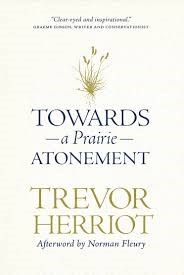“Towards a Prairie Atonement”
by Trevor Herriot
Published by University of Regina Press
$22.95 ISBN 9780889779648
Award-winning writer, prairie naturalist, and birder extraordinaire—Regina's Trevor Herriot requires little introduction. River in a Dry Land: bestseller. CBC Radio: regular. I’ve just devoured Herriot’s Towards a Prairie Atonement—an eloquent treatise on the interconnected injustices that colonialism and profit-at- all-costs dealt the prairie Métis and all living things dependent upon the Aspen Parkland grasslands. Though compact, this three-part essay dispenses an enormous amount of history, appeals for a reckoning and delivers a few slight feathers of ecological hope. Herriot says he “set [his] heart on telling a story that [would] inspire people to take a second look at what we all lost, and could yet restore, in our regard for more sophisticated and nuanced forms of land governance”.
The wisely-woven text begins with a map of the Saskatchewan and Manitoba rivers and historical sites discussed, and an edifying timeline that stretches from the 1600s to 2012. These centuries saw the beginnings of Canada’s fur trade; the North West and Hudson’s Bay Companies jostling; buffalo’s demise; a plethora of government decisions that greatly impacted upon the Métis; the plight of Louis Riel; the establishment (and consequent brutal displacement) of a 250- strong Métis settlement around the Ste. Madeleine mission north of Fort Ellice; the institution of community pastures in Saskatchewan and Manitoba via the Prairie Farm Rehabilitation Act (the Canadian government’s response to the Dirty Thirties); and Stephen Harper’s reckless gutting of the PFRA, created in 1935 for the “protection and programming for vulnerable grassland ecosystems”.
With each of Herriot’s books, it’s not just what he says (and considering his passion, intelligence and concern, he has much to say) that appeals, it’s also how he says it. Birds are never far away, and here we find the longspur’s “warm and holy” eggs in his initial paragraph, where he’s walking, as he’s done for two decades, “onto the scattered archipelago of native prairie islands surrounded by a sea of cash crops”.
His human company in this story includes fellow grassland naturalist and photographer Branimir Gjetvaj and Michif Elder Norman Fleury; Fleury provided the book’s “Afterword”. Together they walk and talk in the Spy Hill-Ellice community pasture among rare birds, “small mandalas of antennaria in bloom,” and the Ste. Madeleine headstones. At this site years before, the Métis “spoke the language, sang the songs, and told the stories that their fur-trading ancestors first voiced in the prairie world”. Even now, Métis (“new people who were not this and not that,” Fleury says) families gather at the pasture’s “well-tended” campsite for a summer celebration, and indeed, the import of community and “how the prairie might bring us together” are part of what Herriot advocates. The Michif are tenacious.
Colonialism, Herriot asserts, is “an utterly unreliable narrator” and atonement begins with “recognizing and honouring what was and is native” but’s been “evicted from the land — native plants and animals but the original peoples, cultures, and languages too.” I assert that Herriot’s a completely reliable narrator, and I’ll never tire of his imperative themes.
This book is available at your local bookstore or from www.skbooks.com.



